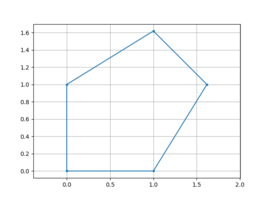MathIsEverything
New member
- Joined
- Sep 17, 2022
- Messages
- 14
Hello I'm struggling with this problem:
In a convex pentagon ABCDE, each diagonal cuts a triangle with an area of 1. Calculate the area of the pentagon.
My main question is whether this pentagon is regular and if it is how to prove that. When you prove that this problem becomes very easy, and i solved that, for regular pentagon. I should be trying to prove that it is a convex pentagon or I should be trying to solve that without knowing It is regular. Thanks for helping
In a convex pentagon ABCDE, each diagonal cuts a triangle with an area of 1. Calculate the area of the pentagon.
My main question is whether this pentagon is regular and if it is how to prove that. When you prove that this problem becomes very easy, and i solved that, for regular pentagon. I should be trying to prove that it is a convex pentagon or I should be trying to solve that without knowing It is regular. Thanks for helping

